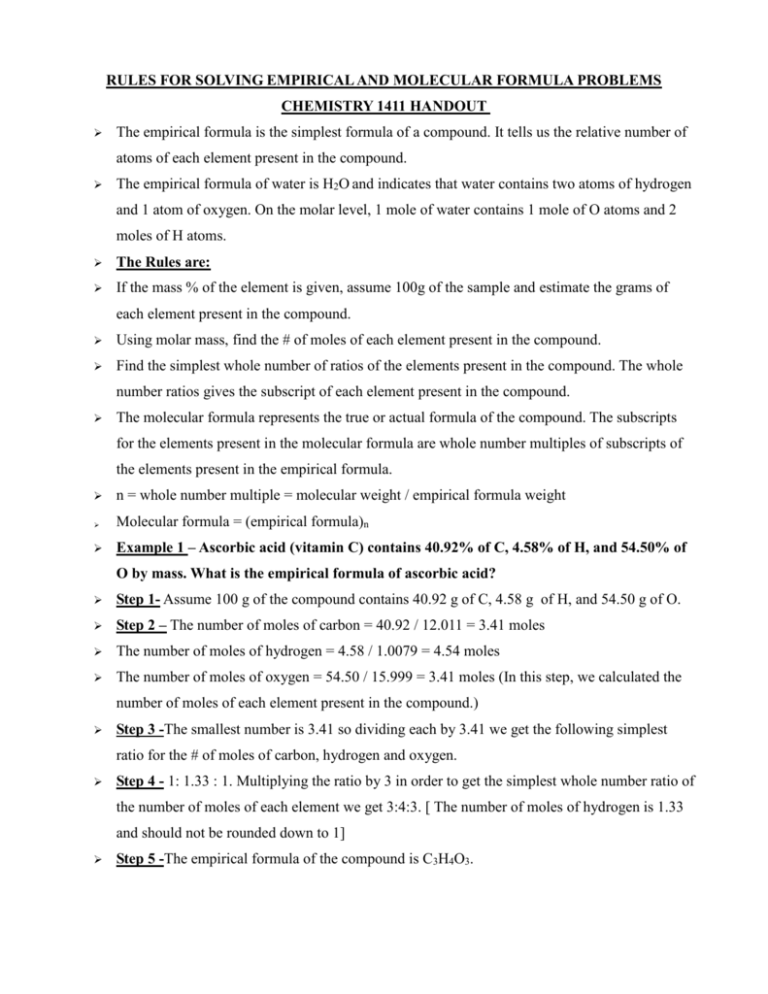Empirical and molecular formula handout
advertisement

RULES FOR SOLVING EMPIRICAL AND MOLECULAR FORMULA PROBLEMS CHEMISTRY 1411 HANDOUT The empirical formula is the simplest formula of a compound. It tells us the relative number of atoms of each element present in the compound. The empirical formula of water is H2O and indicates that water contains two atoms of hydrogen and 1 atom of oxygen. On the molar level, 1 mole of water contains 1 mole of O atoms and 2 moles of H atoms. The Rules are: If the mass % of the element is given, assume 100g of the sample and estimate the grams of each element present in the compound. Using molar mass, find the # of moles of each element present in the compound. Find the simplest whole number of ratios of the elements present in the compound. The whole number ratios gives the subscript of each element present in the compound. The molecular formula represents the true or actual formula of the compound. The subscripts for the elements present in the molecular formula are whole number multiples of subscripts of the elements present in the empirical formula. n = whole number multiple = molecular weight / empirical formula weight Molecular formula = (empirical formula)n Example 1 – Ascorbic acid (vitamin C) contains 40.92% of C, 4.58% of H, and 54.50% of O by mass. What is the empirical formula of ascorbic acid? Step 1- Assume 100 g of the compound contains 40.92 g of C, 4.58 g of H, and 54.50 g of O. Step 2 – The number of moles of carbon = 40.92 / 12.011 = 3.41 moles The number of moles of hydrogen = 4.58 / 1.0079 = 4.54 moles The number of moles of oxygen = 54.50 / 15.999 = 3.41 moles (In this step, we calculated the number of moles of each element present in the compound.) Step 3 -The smallest number is 3.41 so dividing each by 3.41 we get the following simplest ratio for the # of moles of carbon, hydrogen and oxygen. Step 4 - 1: 1.33 : 1. Multiplying the ratio by 3 in order to get the simplest whole number ratio of the number of moles of each element we get 3:4:3. [ The number of moles of hydrogen is 1.33 and should not be rounded down to 1] Step 5 -The empirical formula of the compound is C3H4O3. Example 2 – Mesitylene, a hydrocarbon that occurs in small amounts in crude oil, has an empirical formula of C3H4. The experimentally determined molecular weight of mesitylene is 121 amu. What is the molecular formula of mesitylene? Step 1 – The empirical formula weight of mesitylene is (3 x 12.011 + 4 x 1.0079) = 40.06 amu. The molecular weight of mesitylene is 121 amu. Step 2 - n = whole number multiple = 121 /40.06 = 3.02 which can be taken as 3. Step 3 - The molecular formula of mesitylene = (C3H4)3 = C9H12 Example 3 – Isopropyl alcohol, a substance sold as rubbing alcohol, is composed of C,H and O. Combustion of 0.255 g of isopropyl alcohol produces 0.561 g of CO2 and 0.306 g of H2O. Determine the empirical formula of isopropyl alcohol. Step 1 – We need to find the number of moles of Carbon, Hydrogen and Oxygen. 44 g of CO2 contains 12 g of carbon. Using this concept, we can find the amount of carbon as (0.561 g of CO2) X (12 g of carbon)/ (44g of CO2) = 0.153 g of carbon 18 g of H2O contains 2 g of hydrogen. Using this concept, we can find the amount of hydrogen as (0.306 g of H2O) X (2 g of hydrogen) / (18 g of H2O) = 0.034 g of hydrogen The amount of oxygen present in isopropyl alcohol = 0.255 – (0.153 + 0.034) = 0.068 g of oxygen ( Overall mass of the compound – (mass of carbon + mass of hydrogen) Step 2 – Find the number of moles of each element The number of moles of carbon = 0.153 / 12.011 = 0.013 The number of moles of hydrogen = 0.034 / 1.0079 = 0.034 The number of moles of oxygen = 0.068 / 15.999 = 0.0043 Step 3 - The simplest whole number ratio of the number of moles of carbon : hydrogen : oxygen is 3 : 8 : 1. Step 4 - The empirical formula of isopropyl alcohol is C3H8O.







